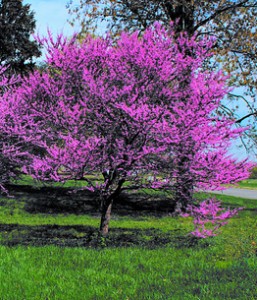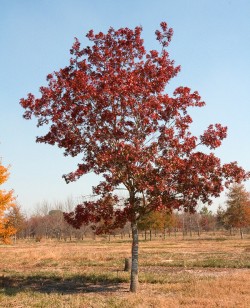Skip to a section:
- Costs – When Oklahoma City, Oklahoma residents started getting free trees from city officials, they were also given the new responsibility of maintaining those trees. Learn what those costs are by reading all the statistics we have on tree maintenance.
- FAQs – Oklahoma City is working its way back from the 2007 ice storm with one tree (or 1,000) at a time. Learn more about the trees best suited to do it, more on the state tree, plant hardiness by zone in the state and more!
- Services – Need someone to help support and maintain one of those 1,000 trees from the city? We have professionals listed with their information below that you can call!
How Much Do Tree Services Cost in Oklahoma City?
Oklahoma City, Oklahoma is home to 5,000 new trees in addition to the ones that survived the ice storm in 2007. If you’re a proud owners of one of those trees or a survivor tree, here’s what you need to know about keeping it alive and healthy.

How Much Does Tree Removal Cost?
If one of your ice storm survivor trees has finally decided it’s time, then you will need to call a tree service professional. When he comes, the quoted price will be between $422 and $602 for the service, with an average cost of $512 for removing the tree. This exempts any circumstance including it being near a power line, an extensive amount of branches requiring pruning ahead of time or its proximity to your home, which could increase price.
How Much Does Stump Removal Cost?
If you have a stump in your backyard left from a tree that didn’t survive the ice storm, then you can a tree service professional out to remove it. It will cost between $80 and $150 to have the stump ground down, while having the stump removed will cost around $250 to $350. See what the best option is for your budget and plans for your yard.
Average Cost of Tree Maintenance in Oklahoma City
Maintaining a tree, especially one of those 5,000 new ones, will be far more cost-effective than cutting a tree down. Pruning, cutting or trimming a tree will probably cost between $300 to $500 depending on the complexity of the job. It won’t be as necessary with the young trees until they’re older and well-developed, but the survivor trees need regular care after surviving the ice storm.
Oklahoma City Tree Facts & FAQ
The 5,000 new trees residents of Oklahoma City own came from the city itself. They started giving them away, 1,000 every year, after the ice storm hit the city in 2007 and decimated much of its tree population. That’s why it is important for residents to take care of those trees and even plant more of their own if possible.
Rules and Regulations
Oklahoma City does not require permits before removing a tree, but there are specific rules that tree service professionals must follow when removing a tree. Those include topping a tree before taking it down, lowering large limbs with ropes, and cutting stumps two inches to the ground so grass can grow. The best time to remove a tree in Oklahoma City is during the late fall or early winter. This will be before the ice storms will hit the Midwest and therefore keep your property or home from getting severe damages by way of the tree falling on it.
Common Trees to Plant in Oklahoma City


Oklahoma City is home to a lot of varieties of trees, some that can grow over 50 feet tall and others that reach only about 25 feet tall. Oklahoma’s state tree, the redbud (Cercis canadensis), has reddish-pink blossoms that can give color to any yard in the spring. Choosing trees that best fit the backyard is the city’s recommendation, as to avoid power lines, water lines and general issues with the home and garden. Some of the common types indigenous to Oklahoma City include:
- Bosnian pine (Pinus heldreichii)
- Caddo maple (Acer saccharum)
- Shumard oak (Quercus shumardii)
- Persian ironwood (Parrotia persica)
Oklahoma City’s climate and soil conditions also support apple and peach trees. Apples can handle the colder climate Oklahoma has during the fall and winter months, and peaches thrive in the spring and summer months. As long as residents don’t have soil that’s too wet, their peaches should grow just fine.
Difficult to Maintain Trees
Oklahoma City’s climate means that some of its trees are more amenable to breaking during storms or infection from disease and pests. These include:
- Cottonless cottonwood (Populus deltoides ‘Cottonless’)
- Washington hawthorn (Crataegus phaenopyrum)
- Russian olive (Eleagnus angustifolia)
- Flowering crabapple (Malus spp.)
- Thornless cockspur hawthorn (Crataegus crus-galli ‘Inermis‘)
Diseases Affecting Oklahoma City’s Trees
Hypoxylon canker is a disease affecting many of the trees in Oklahoma City with rising frequency since 1979. It’s a fungal infections that’s almost always fatal and starts with pieces of the bark falling off. Pine wilt, transmitted by the long-horned beetle, is another infection that hurts non-native pine trees in the city by causing their needles to yellow or brown and then the branches to wilt, eventually killing the tree. Cedar apple rust appears on cedars and junipers in the spring and can be pruned off before it takes control of the tree. Pinewood nematode is a disease that can be confused with drought conditions on pines, where the needles brown, but the wood pitch only needs to be cut from that area to stop the disease from spreading.
Rules Regarding Trees and Overhead Power Lines
OG&E, Oklahoma’s utlity company, recommends trees that will reach 25 feet should be planted 15 feet away from electric lines. Those that reach 40 feet should be planted 20 feet away from electric lines. Then any that could reach 40 feet should be at least 50 feet away from electric lines.
Plant Hardiness Zones for Oklahoma
Here are the plant hardiness zones for Oklahoma as provided by the USDA:

Image Sources:
Redbud
Shumard oak
Local Tree Services in Oklahoma City
Featured Tree Services in Oklahoma City
Valenzuela Tree Service
Phone:(405) 314-1313
Service Areas: OKC, Edmond, Norman, Moore
Services Offered:Tree removal, Stump Grinding
Website: http://www.valenzuelatreeservice.com/home.html
Deals: 1/2 Price for senior citizens
